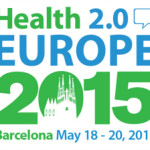 Is the Uber minicab model fit for healthcare? Why are doctors terrible digital adopters? And can the medical workforce benefit from using applications which promise virtual doctors on demand?
Is the Uber minicab model fit for healthcare? Why are doctors terrible digital adopters? And can the medical workforce benefit from using applications which promise virtual doctors on demand?
These questions and others were debated at day 1 of technology conference Health 2:0, an annual event which profiles “international innovation in patient-provider communication, consumer health, data analytics, and more.”
The BMJ is a media partner and participated in the Digital Doctors Lounge session, where I outlined how the journal is trying to embed the patient perspective in our research and educational content.
But first….meet Molly (or Olivia, if you’re in the UK), “your virtual medical assistant.” Ivana Schnur is chief medical officer and co-founder of Sense.ly, which created Molly. Wearing a remote hypertension cuff, Molly told Ivana her blood pressure was high and offered to send her results to her physician. Molly’s 24/7 availability can help address the “clinical cul de sac,” Schnurr explained, telling doctors in the audience that as well as measuring hypertension, Molly can schedule appointments, deliver lab results, and that behind her “is a clinical engine that allows patients to see patients stratified by risk.”
How does Molly handle patients with “low health literacy?” Molly is intelligent, says Schnur, moments after being asked by Molly how her jetlag was (the conference is in Barcelona).
Molly was not the only virtual clinician in the room yesterday. Waldemar Hogerwaard unveiled eGPO, an “electronic health record supplement designed to enhance the patient-provider relationship.”
eGPO can summon clinicians to intervene when a patient presents with multiple problems, tapping into a database of specialists based nearby. His demo showed how someone caring for a patient experiencing abdominal pain and who has suspected dementia can alert a local “dream team” of doctors and psychologists, who can link up remotely, access the patient’s records, and suggest options.
Richard Jefferson, head of programme commissioning at NHS England, asked how scaleable eGPO is in a country less condendsed than the Netherlands, where eGPO was developed.
How, for example, would eGPO deal with two English cities, who commissioned separately but had specialists working across both settings? Perhaps one city uses a different product? Hogerwaard said the product’s API meant it could integrate with other providers.
Trond Ase’s avatars are helping employees of a Norwegian hospital still under construction navigate their way around its corridors.
A virtual architectural model opened before our eyes, taking us to visit patients and hold meetings. Ase’s company, Attensi, uses simulation to test and implement procedures.
With all this innovation happening, some of it led by doctors, it was a surprise to hear conference keynote speaker Homero Rivas say physicians are terrible digital adopters.
Rivas, director of innovative surgery at Stanford School of Medicine , argued that medical training is risk averse and conservative, unlike innovators, who have a tolerance of failure, who are open minded, friendly to risk, and persistent.
Innovation is particularly hard in the US, he added, because scarcity triggers creativity, which is why India can offer heart surgery for $990, whereas a gastric bypass costs $130,000 in the US.
So can Uber be applied to healthcare? Apparently yes. Somewhere in the world (the US, I expect) nurses travel around in cars delivering flu shots.
David Payne is digital editor, The BMJ.

